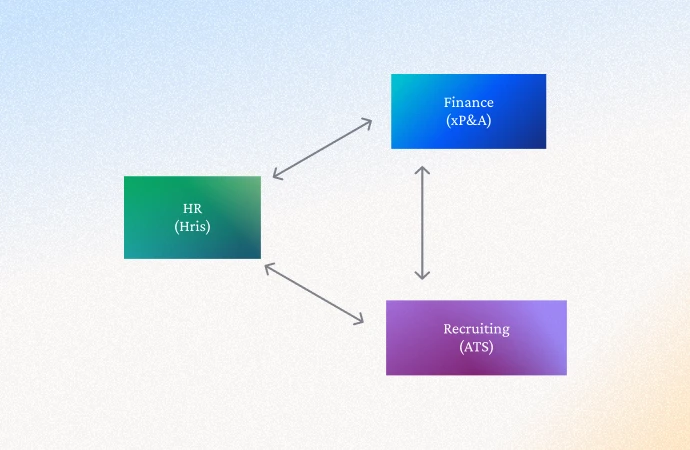Table of Contents
Workforce planning, broadly defined, is the process through which an organization seeks to understand current and future workforce needs. Whatever the short or long-term goals of your organization are, the first step to achieving them will be to ensure it’s the correct size and shape.
But getting this process right can be extremely challenging - it involves a multitude of different data sources, requires close collaboration between stakeholders in finance and HR, and relies on a great deal of foresight, which can be challenging in a shifting business environment.
Step 1: Understand the current state of your workforce
Analyzing the current workforce is a critical component of workforce planning that allows HR leaders to understand the existing capabilities, skills, and potential gaps within the organization.
To do this, you’ll need to get a handle on your data. There are a lot of systems involved with workforce planning - HRIS, ATS, ERP - and they all need to work together if you are to achieve a holistic picture of the workforce in its current state (and potential future states).

Involving operational and business data and stakeholders is important - workforce planning cannot happen with HR and finance operating in isolation. Only by involving every department can you gain an accurate baseline of the size and shape of your workforce, to then measure against your business objectives.
Organizations with advanced WFP maturity will have a clear handle on their workforce data (demographics, distribution, positions and locations, etc…), giving them a clear picture of the state of play.
Some key metrics to keep track of include:
Turnover rate
A company's turnover rate is the number of employees who leave during a given period, typically a year.
Turnover rate = Number of employee exits / Total headcount
Most reasons for turnover are voluntarily initiated by employees who quit or change employers. Involuntary employee turnover occurs when employers lay off workers for subpar performance, failing to complete a probationary period, redundancy, or breaking corporate policy.
Attrition rate
Attrition describes the natural turnover of employees. Attrition specifically refers to voluntary exits, when an employee leaves of their own accord.
Attrition rate = Number of voluntary employee exits / Total headcount
It is important to monitor attrition levels carefully, as too much attrition can lead to negative consequences such as a drop in productivity or an increase in absenteeism.
Failed hires and reasons for resignation
Where new hires don’t make it to 1 year within the organization and where they voluntarily resign, asking and recording the reasons given at exit interview can provide insight into broader trends within the organization.
Ramp time
Ramp time is the period of time between a new employee's hiring and the time when they begin to be productive at their new position. Existing documentation on guidelines, processes to follow, and training programs for new hires can reduce ramp time.
Tenure distribution
Allows you to keep track of the average tenure of an employee at your company. If most of your senior leadership have been hired externally, you know you might want to address your training and development programs.
Time-to-hire
Consider opening the position on November 1st, receiving the first application on November 5th, and successfully closing the position on November 29th. The time it takes to hire (time-to-hire) a candidate for a particular position is 24 days.
The risk of applicants slipping out of the funnel increases during delays in the recruitment process. The longer those delays last, the worse they are for both the applicants and your team. The more time and money you invest in what could be a simple hiring process through tests and interviews, the more expensive it becomes.
Full-time equivalents (FTE)
Employers can standardize their headcount by combining their part-time workers' hours to determine how many full-time employees would work those hours using the full-time equivalent (FTE) method.
A part-time employee working 26 hours a week, for instance, would have an FTE value of 0.65 (26 hours worked / 40 hours).
Employee net promoter score (eNPS)
eNPS refers to a person's inclination to suggest their employer to family and acquaintances. High eNPS scores, in other words, show that employees are loyal to and engaged with a company.
It’s at this stage when organizations should conduct skills mapping. Generally, this involves individuals and their managers working through and filling in a skills matrix - a table that tracks competency across factors deemed relevant to their role.
.webp)
Step 2: Conduct demand forecasting
Once you understand where you are, the next step will be to plot where you’re going. Workforce demand forecasting involves figuring out what your workforce requirements will be in the future, based on the overall business plan.
To conduct demand forecasting, you’ll need to get close to business leaders to understand factors like:
- Growth targets - what are the targets your organization is working towards? What are the implications of them (acquisitions, expansions into new territories, etc).
- The strategic direction of the company - what are the plans for the next five years? Does the company have any major initiatives or ‘big bets’ that you’ll need to think about?
- Any major shifts in government policy or regulation that your organization will need to comply with over the coming years.
- Plans for digital transformation and other similar projects. Automation and AI will hold many benefits for (and demand changes from) the workforce and you’ll need to project what these might be.
- Competitor activity and trends in the marketplace - it’s good to have an understanding of the direction of travel for both.
Once the above has been established, you can then begin to estimate what your future workforce requirements will look like. There are a number of different methods for doing this, including:
- Managerial analysis
Ask managers and department heads to estimate themselves what they’ll need in the future. It may not be the most accurate, but it’s certainly a helpful starting point. - Benchmarking against other organizations
By comparing your organization with another that is analogous to where you’re hoping to be, you can make assumptions about the requirements you’ll have to meet. - Advanced statistical forecasting
By using techniques like regression analysis or time series forecasting, organizations can use historical data to forecast future workforce needs. - Delphi technique
A series of questions are given a panel made up of key internal employees and external experts. After gathering the questionnaire responses, the leader summarizes all the answers and sends this summary back to the panel for review. This process is repeated until the majority of the experts agree on a decision. - Workload analysis
This involves first predicting the total amount of services or goods that will be produced over a specific period. Then, use historical data to estimate how many employees will be needed to meet this production target.
Scenario analysis is another key part of any successful workforce planning strategy. Rather than just developing one plan, this enables your organization to prepare for any number of different scenarios that might play out - and you can conduct it using any (or a combination of) all the methods above.
Step 3: Gap analysis
Now you know where you need to go, you need to build a strategy to get there. That will involve a number of different initiatives, all based on your specific goals.
Gap analysis is the process of identifying the difference between the current workforce you have and what you will need in the future. It's about clearly understanding this gap and the challenges it presents to your organization. Essentially, gap analysis compares your current resources to your ideal requirements.
Questions to consider when conducting gap analysis:
- What skills or competencies are lacking in my workforce?
- How are we updating these skills to keep up with changes in the business environment?
- Are there specific roles or locations where it's difficult to find employees?
- Do some roles demand skills that are difficult to find?
- Where are the diversity shortfalls in our workforce?
Step 4: Strategy development
Now you understand where you have gaps, it’s time to fill them - and there are a number of different methods you can use to do that.
A helpful framework to think about the levers you have available to pull with regards to your workforce is the 7Bs. They are:
Buy: Acquire essential external talent through recruitment, entry-level programs, graduate and apprentice hires, along with competitive pay and rewards.
Build: Develop internal talent through career progression opportunities, succession planning, learning and development, talent identification programs, focusing on high-potential employees, enhancing diversity, and fostering a positive organizational culture.
Borrow: Engage temporary talent through contracts, outsourcing, or onboarding personnel temporarily (such as through secondments, contingent labor, professional services, or seasonal temporary staff).
Bind: Retain critical employees and their skills by offering attractive pay, benefits, secure contracts, long-term tenure, and commitments to return service.
Bounce: Manage workforce adjustments by removing employees through redundancies, redeployments, exits, or by utilizing secondments and partnership schemes for performance management.
Bot: Implement automation to enhance or substitute current capacity and capabilities using technology like robotic process automation, machine learning, and cognitive automation technologies.
Balance: Ensure that you’re achieving your goals with an appropriate mix of all of the other Bs.
Each of these methods will operate on different timeframes to implement: you must assess and balance the time taken to implement the changes with the level of confidence you have in the forecast for demand. Do you need to act now? Do you have time to see how it will play out? How reversible are the changes that you’re making? These are all questions to ask.
Step 5: Monitoring and continuous improvement
Workforce planning is never finished - you must consistently track the performance of your strategies and assess their effectiveness. As your goals, workforce, and market conditions evolve, it's necessary to adjust your workforce plan in line with them.
To ensure you’re doing a good job of this, there are three key steps you can take:
- Set clear KPIs
Establish and monitor continuously the metrics that you believe will give the most accurate picture of whether or not you’re on track. - Establish regular review processes
Decide upon a cadence that works for you to regularly meet with the relevant team member and review the plan - does it still hold up? You should plan to examine variance between your forecasts and actual performance when data becomes available.
Encourage and facilitate feedback
Workforce planning includes a large number of different individuals from all across your organization, some of whom will need to invest a significant amount of their own time. It’s important to understand what parts of the process are working, and which might need improving.
Next steps
To learn more about workforce planning, download Workforce Planning: An HR Leader's Playbook.
.jpeg)











